Draco is a circumpolar constellation, meaning that it never sets below the horizon for many observers in the northern hemisphere. It has nine stars with known planets and contains one Messier object, M102, as well as several famous deep sky objects such as the Cat’s Eye Nebula, the Spindle Galaxy and the Tadpole Galaxy. There is one meteor shower associated with the constellation — the Draconids.
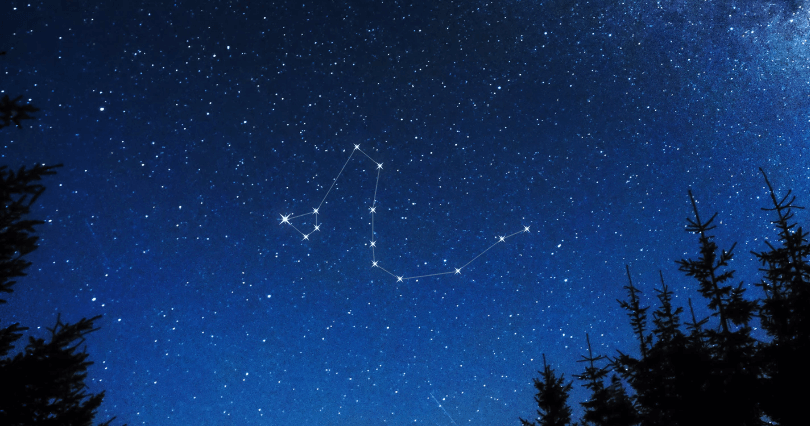
The Draco Constellation contains 17 formally named stars. The star names approved by the International Astronomical Union (IAU) are Aldhibah, Alrakis, Alruba, Alsafi, Altais, Athebyne, Dziban, Edasich, Eltanin, Fafnir, Funi, Giausar, Grumium, Rastaban, Taiyi, Thuban and Tianyi. The brightest star in the constellation is Eltanin.
History and Mythology Of The Draco Constellation
Draco was first catalogued by the Greek astronomer Ptolemy in the 2nd century. While it is associated with several myths, it is most frequently associated with the 12 labours of Heracles. In the myth, Draco represents Ladon, the dragon that guarded the golden apples in the gardens of the Hesperides.
The apple tree was a wedding present to Hera when she married Zeus, and she planted it in her garden. She tasked Atlas’ daughters, the Hesperides, with guarding it, and placed the dragon Ladon around the tree so that the Hesperides would not pick any apples from it.
As part of his 12 labours, Heracles was asked to steal some golden apples from the tree. He killed Landon while doing so, so Hera placed its image in the sky among the constellations.
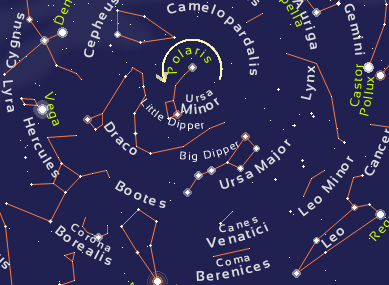
Location Of The Draco Constellation
Draco constellation occupies and area of 1083 square degrees and is the eighth largest constellation in the night sky. It lies in the third quadrant of the northern hemisphere (NQ3) and can be seen at latitudes between +90° and -15°.
Its right ascension is 17h and its declination is +65°. It is best visible at 9pm during the month of July.
Draco belongs to the Ursa Major family of constellations, along with Coma Berenices, Boötes, Camelopardalis, Canes Venatici, Corona Borealis, Leo Minor, Lynx, Ursa Major and Ursa Minor. The neighboring constellations are Boötes, Camelopardalis, Cepheus, Cygnus, Hercules, Lyra, Ursa Major, and Ursa Minor.
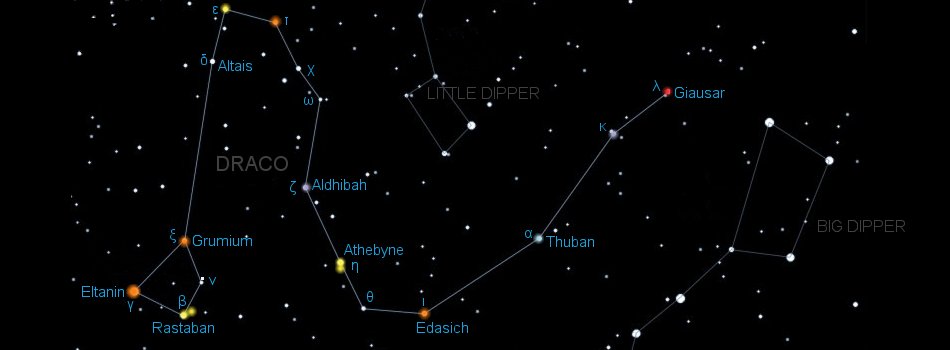
Notable Stars In The Draco Constellation
There are a number of notable stars in the constellation of Draco, of which Eltanin is the brightest.
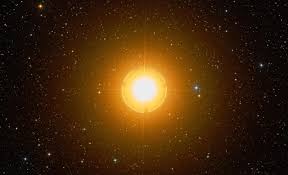
Eltanin
Eltanin, also known as Gamma Draconis, is the brightest star in Draco with an apparent magnitude of 2.3617. It is an evolved giant and belongs to the spectral class K5 III. It is located around 154.3 light years distant from the Solar System and is 471 times more luminous than the Sun. Eltanin also has 72 percent more mass than the Sun.
Eltanin has a companion with a visual magnitude of 13.4, likely a red dwarf that may be a physical companion, not just an optical one. It is pretty easy to find in the night sky, lying just north-northwest of Vega, which is the brightest star in the constellation of Lyra.
The star’s name comes from the Arabic At-Tinnin, which means “the great serpent”. It is sometimes known as the Zenith Star because it lies close to the zenith point directly overhead in London.
In about 1.5 million years, the star with pass within 28 light years of Earth and be the brightest star in the sky.
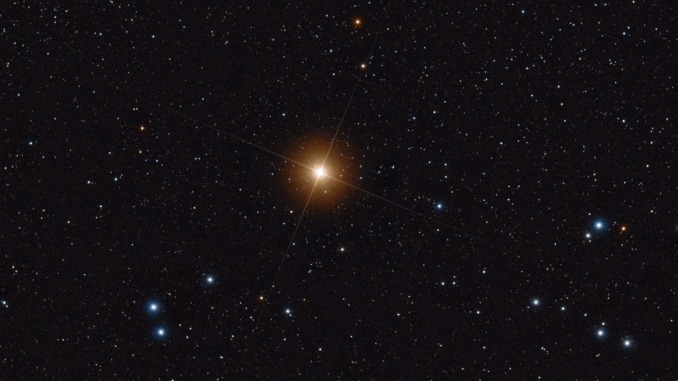
Aldibain
Aldibain, also known as Eta Draconis, is the second brightest star in Draco and has an apparent magnitude of 2.73. It is a giant star belonging to the spectral class G8 III and is located approximately 92.1 light years distant from the Solar System. It is 60 times more luminous than the Sun and is thought to be around 550 million years old.
Aldibain has a companion located 5.1 arc seconds away. It is a K2 V-class main sequence star with a visual magnitude of 8.8. The two stars have an orbital period of at least a millennium.
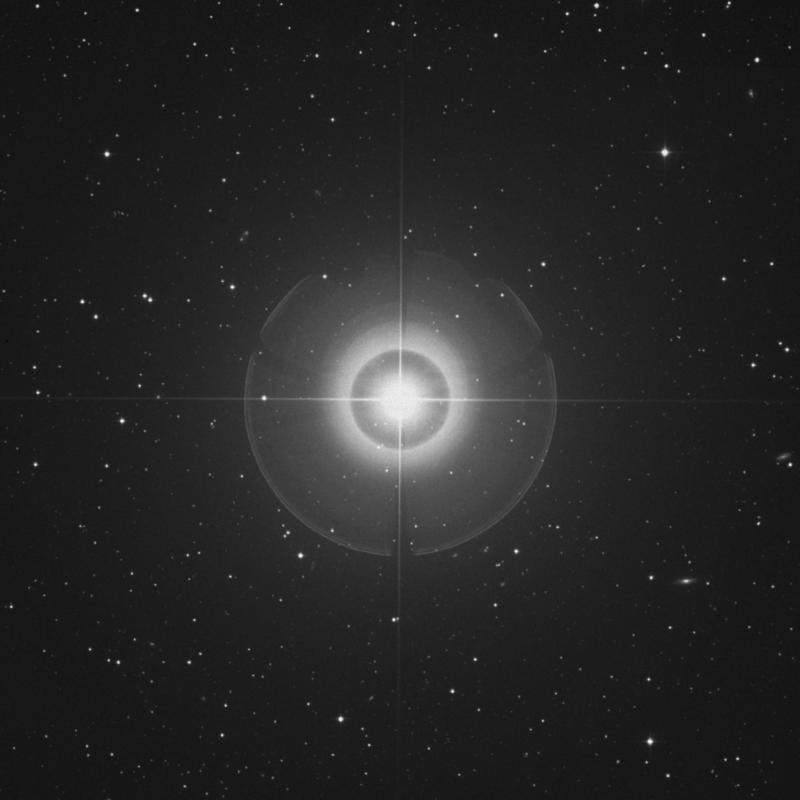
Rastaban
Rastaban, also known as Beta Draconis, is the third brightest star in the constellation of Draco and has a visual magnitude of 2.79. It is a yellow star of the spectral type G2, located around 380 light years away from us. It is around 950 times more luminous than the Sun and has a radius that is 40 times that of the Sun. Rastaban also has a mass than is six times that of the Sun.
Rastaban has a dwarf star for a companion, which makes it a binary system. It is thought to be 67 million years old.
Its name comes from the Arabic ra’s ath-thu’ban, which means “the head of the serpent”.
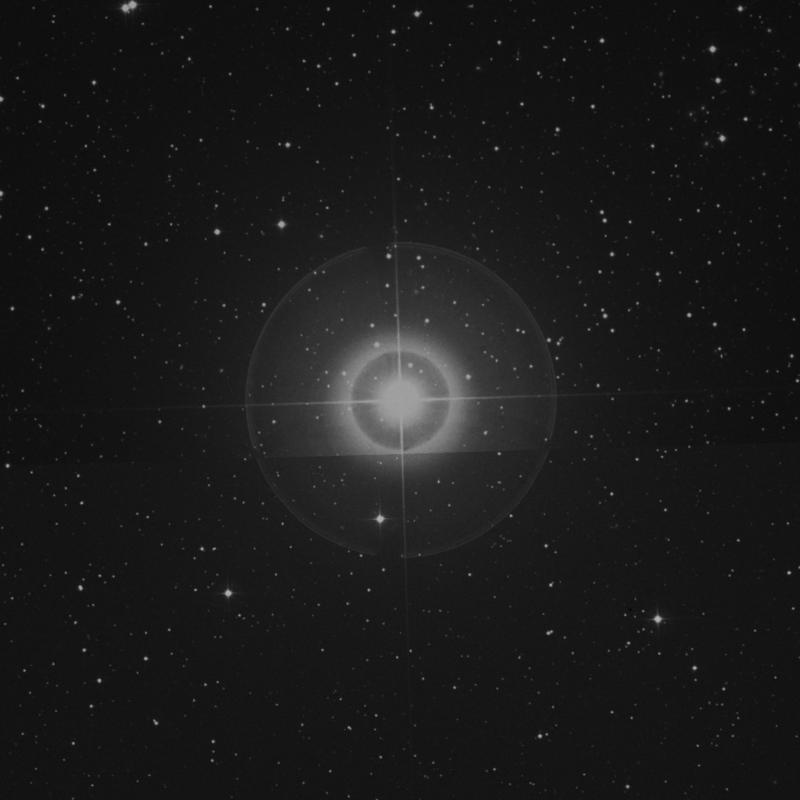
Altais
Altais, also known as Delta Draconis, is a yellow giant star of the spectral type G9 III. It has an apparent magnitude of 3.07 and is located around 97.4 light years distant from Earth. It is 59 times more luminous than the Sun and is thought to be 97.4 light years away from Earth.
Its names comes from the Arabic Al Tāis which means “the goat”.
Aldhibah
Aldhibah, also known as Zeta Draconis, is the fifth brightest star in Draco and a giant star of the spectral type B6 III. It is 330 light years away from us and has an apparent magnitude of 3.17. It is 148 times more luminous than the Sun and 2.5 times larger than the Sun.
The name Aldhibah means “the hyenas” in Arabic, although the star is also sometimes called Nodus III, or the Third Knot, referring to a loop in Draco’s tail.
Edasich
Edasich, also known as Iota Draconis, is a giant of the spectral type K2 III that is approximately 101.2 light years distant from Earth. It has a visual magnitude of 3.290 and is slightly more massive than the Sun. It has a radius that is 12 times that of the Sun and is 55 times more luminous.
Edasich has a planet in its orbit that was discovered in 2002 and it was the first planet discovered to orbit a giant star. It is also believed to have a debris disk surrounding it.
Batentaban Borealis
Batentaban Borealis, also known as Chi Draconis, is a star system composed of a yellow-white star of the class F7V, and an orange, class K0V star. The yellow-white star has a visual magnitude of 3.68 and is almost twice as luminous as the Sun, while the orange star has a magnitude of 5.67. Together, they have a combined magnitude of the system is 3.570 and the system is located 26.3 light years away from us.
The two stars in Batentaban Borealis form a spectroscopic binary and orbit each other with a period of 280.55 days.
Batentaban Australis
Batentaban Australis, also known as Phi Draconis, is a multiple star composed of hydrogen fusing dwarfs and has the stellar classification A0sp. It is about 300 light years away from us and has an apparent magnitude of 4.2004.
The two brighter components in the system orbit each other with a period of 307.8 years. The primary component, Phi Draconis A, is an unresolvable binary star.
Batentaban Australis cannot be seen in latitudes south of the Tropic of Capricorn.
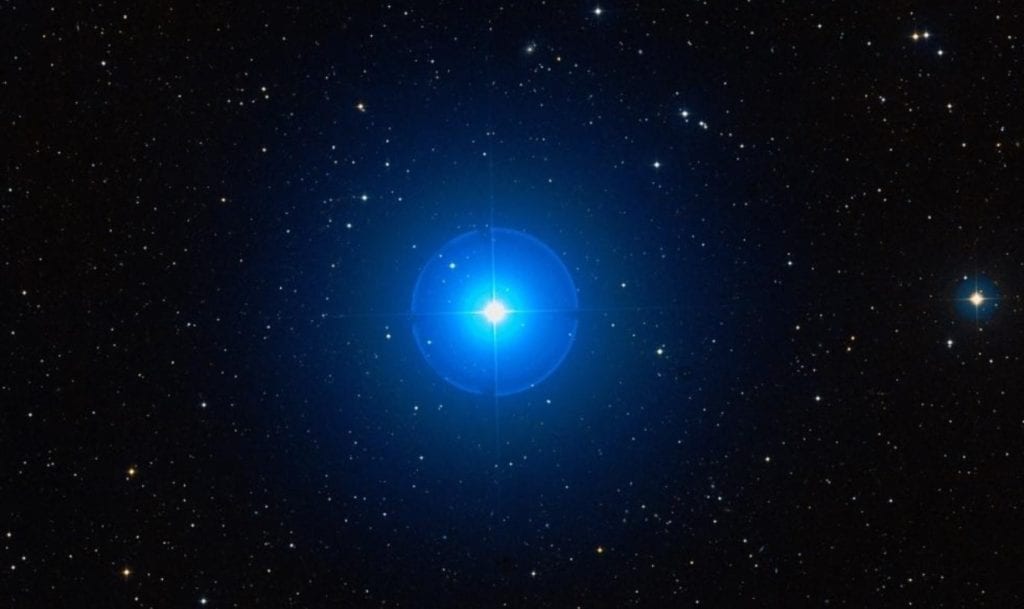
Thuban
Thuban, also known as Alpha Draconis, is a white giant star that belongs to the spectral class A0III. It has an apparent magnitude of 3.6452 and is approximately 303 light years away from us. It is 250 times more luminous than the Sun.
Thuban is a double star. The main star has a companion, which is either a red or white dwarf. Its name comes from the Arabic thuʿbān, which means “the snake.”
Alpha Draconis was the North Pole star from 3942 to 1793 BC. It can be found by following the line from the inner two stars of the Big Dipper, Phecda and Megrez, which point in its direction.
Grumium
Grumium, also known as Xi Draconis, belongs to the spectral class K2 III. It has an apparent magnitude of 3.75 and is 112.5 light years away from us.
Gianfar
Gianfar, also known as Giausar or Lambda Draconis, is a M0 class star that has an apparent magnitude of 4.1. It is located 334 light years away.
Tyl
Tyl, also known as Epsilon Draconis, is a yellow giant of the spectral type G8III. It has a visual magnitude of 3.9974 and is 60 times more luminous than the Sun. It is approximately 148 light years away from us and is thought to be 500 million years old, making it a relatively young star for a G class star.
Tyl takes around 420 days to make a complete revolution with a rotational velocity of 1.2 km/s. The main star has an orange dwarf companion of the class K5. it has a visual magnitude of 7.3 and located 3.2 arc seconds away.
Shǎowèi
Shǎowèi, also known as Kappa Draconis, has a visual magnitude of 3.82. It is a blue giant belonging to the spectral class B6 IIIe and is located approximately 490 light years away from us.
Shǎowèi is believed to be entering its red giant stage. It is five times more massive than the Sun and around 1400 times more luminous.
The star was the closest naked eye star to the North Pole from 1793 to 1000 BC. However, it wasn’t considered the pole star because Kochab, Beta Ursae Minoris, was significantly brighter.
Theta Draconis
Theta Draconis is a yellow-white main sequence star of the spectral type F9 V. It has a visual magnitude of 4.1190 and is around 68.6 light years away from us. It has 2.5 times the Sun’s radius and is 8.7 times more luminous. Theta Draconis is also 21 percent more massive than the Sun.
This yellow-white main sequence star is a very close spectroscopic binary star with an orbital period of 3.0708216 days. Its companion is believed to be an M2 class dwarf. The binary star is a fast rotator, with a speed of 28 km/s or more at the equator.
Omicron Draconis
Omicron Draconis is a spectroscopic binary star. It is a giant belonging to the spectral class K2 III and has a visual magnitude of 4.62 and is 322.93 light years away from us. It has a radius that is 30 times that of the Sun and is 269 times brighter than the Sun.
Omicron Draconis is notable for being the North Pole star of Mercury.
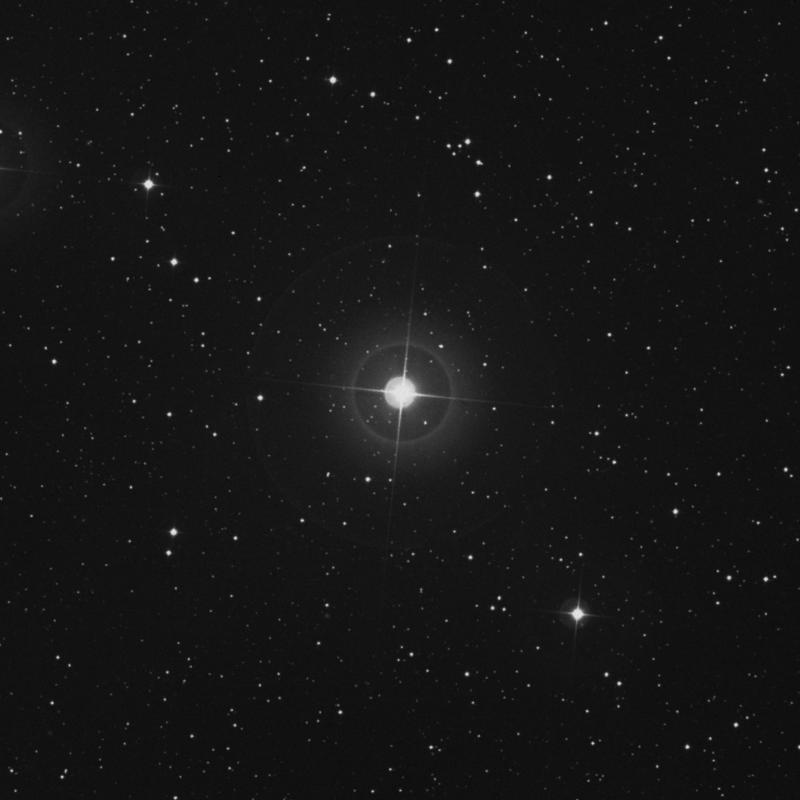
Alsafi
Alsafi, also known as Sigma Draconis, is a main sequence dwarf belonging to the spectral class G9 V. It has an apparent magnitude of 4.674 and is located 18.77 light years away from us. It is smaller than the Sun and has only 43 percent of the Sun’s luminosity.
A companion the size of Jupiter or larger was discovered in the star’s vicinity in 2007.
Arrakis
Arrakis, also known as Mu Draconis, is a double star. The system is around 85 light years away from us and is composed of two F7V class stars. It has a combined apparent magnitude of 4.92.
The name Arrakis is derived from the Arabic word al-Raqis which means “the dancer”.
42 Draconis
42 Draconis is a giant star of the spectral type K1.5III. It has an apparent magnitude of 4.833 and is around 320 light years away from Earth. A super-Jupiter (a gas giant) was discovered in its orbit in 2009.
26 Draconis
26 Draconis is a triple star system located 46 light years from Earth. It is composed of a spectroscopic double star with the spectral classification G0V, while the stars belong to the spectral classes F9V and K3V. The third star in the system is a red dwarf of the spectral type M1V, separated from the main pair by 12.2 arc seconds.
The system has an orbital period of 76 years and the three stars share a common proper motion. They are suspected to be members of the Ursa Major Moving Group.
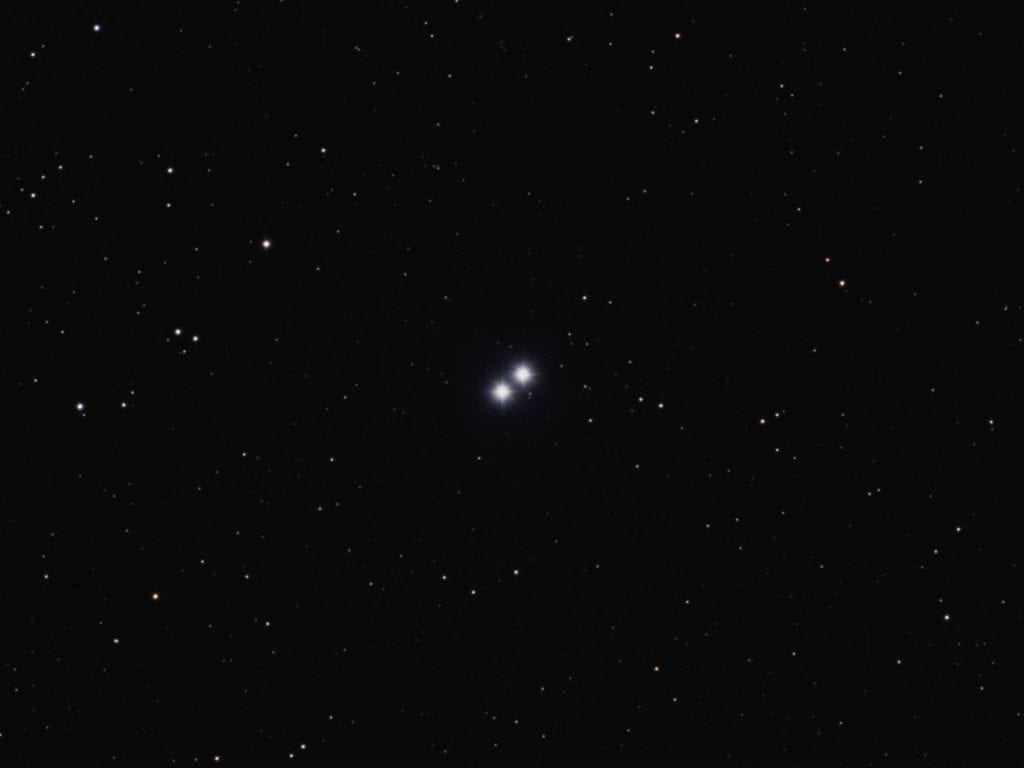
Kuma
Kuma, also known as Nu Draconis, is a binary star composed of ν1 Draconis and ν2 Draconis, which are two similar white A-type stars separated by 62 arc seconds. Together, they have a combined apparent magnitude of 4.13.
The first component is a hydrogen fusing dwarf of the spectral type A6. The second component is an A4 class dwarf and has a dimmer, lower mass companion that completes an orbit every 38.6 days.
BY Draconis
BY Draconis is another multiple star system composed of a close binary star with components orbiting each other every 5.98 days. The two stars are believed to be pre-main sequence, still in the process of collapsing.
The third star in the system is a red dwarf belonging to the spectral class M5. It is separated from the main pair by 17 arc seconds. The system may have a fourth component, but this has not been confirmed.
Struve 2398
Struve 2398, also known as HD 173739/HD 173740 or Gliese 725, is a double star. One is composed of two red dwarfs of the class M3 V and M3.5 V. The stars’ orbital period is 295 years and they are separated by 56 astronomical units on average. They are also a known source of X-rays.
The stars have apparent magnitudes of 8.94 and 9.70 and they are located roughly 11.52 light years away from us.
Kepler-10
Kepler-10 is star that is very similar to the Sun. It is approximately 564 light years away and was the first star identified by the Kepler spacecraft as a possible host to a small transiting exoplanet.
Kepler-10 is a G-class star that is around 11.9 billion years old. It has at least two planets in its system — the first is called Kepler-10b and is a rocky planet discovered in January 2011. It orbits the star with a period of 0.8 days. The second was discovered in May 2011 and is called Kepler-10c. It has an orbital period of 42.3 days.
GD 356
GD 356 is a white dwarf of the spectral type DC7 with a visual magnitude of 15.06. It is around 65 light years away from us and cannot be seen without a telescope.
It is thought to be 2.1 billion years old. The star is also classified as a high field magnetic white dwarf (HFMWD).
Deep Sky Objects
There are many famous nebulae and galaxies in the constellation of Draco. Take a look at the deep sky objects below.
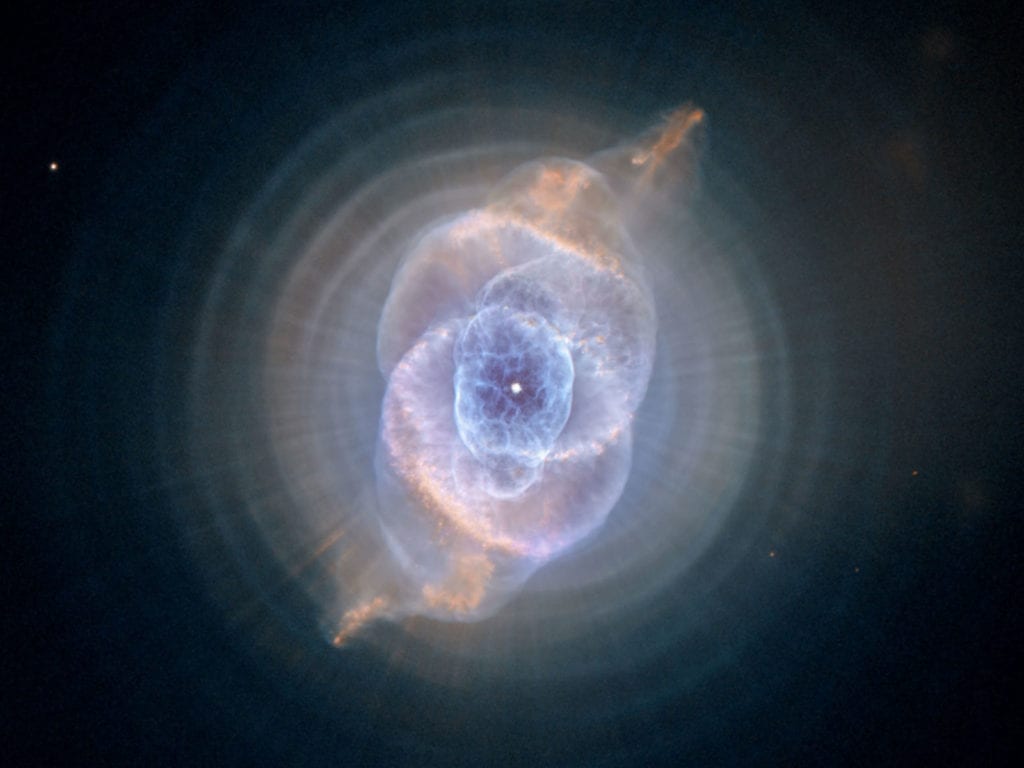
Cat’s Eye Nebula
The Cat’s Eye Nebula, also known as NGC 6543 or Caldwell 6, is a planetary nebula with a visual magnitude of 9.8. It is a very complex nebula, one of the most complex nebulae ever discovered, and is thought to be around 1000 years old. It was formed when a bright hot star lost its outer envelope in the red giant phase. The Cat’s Eye Nebula was discovered by William Herschel in February 1786.
The nebula is around 3300 light years away from Earth. The central star belongs to the spectral class O7 and is about 10,000 times more luminous than the Sun. It is thought to be a binary central star and is thought to be only slightly more massive than the Sun.
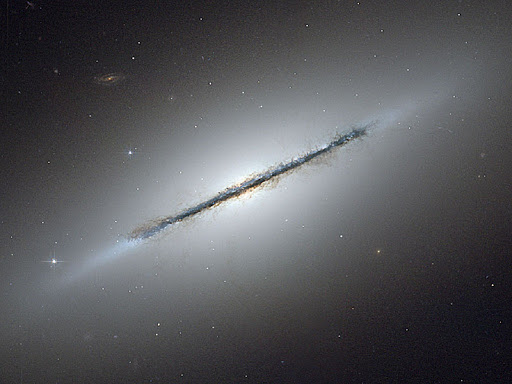
Spindle Galaxy
The Spindle Galaxy, also known as Messier 102 or NGC 5866, is a spiral or lenticular galaxy with an apparent magnitude of 10.7. It is located around 50 million light years away and was discovered in 1781 by either Pierre Méchain or Charles Messier, and then independently discovered by William Herschel in 1788.
The Spindle Galaxy is one of the brightest galaxies in the NGC 5866 group. It also has an extended disk of dust, which is an unusual feature for a lenticular galaxy. However, the galaxy might also be a spiral galaxy, in which case the dust disk would not be unusual.
Draco Dwarf Galaxy
The Draco Dwarf Galaxy is a spheroidal galaxy with a visual magnitude of 10.9. It belongs to the Local Group and is a satellite galaxy of the Milky Way. It is located around 260,000 light years away from Earth and was first discovered by Albert George Wilson in 1954.
The Draco Dwarf Galaxy contains five carbon stars, four suspected asymptotic giant branch (AGB) stars, a number of red giant branch (RGB) stars and more than 260 variables. It is also believed to contain large amounts of dark matter.
Abell 2218
Abell 2218 is a galaxy cluster that contains thousands of galaxies. It is located around 2.345 million light years away.
Abell 2218 was very important in finding the most distant known object in the universe. The cluster was used as a gravitational lens to help find a 13 billion year-old galaxy that is seen from Earth. It appeared only 750 million years after the Big Bang.
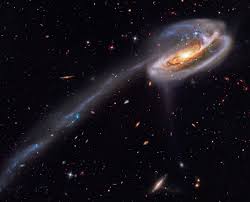
Tadpole Galaxy
The Tadpole Galaxy is a disrupted (collided) barred spiral galaxy that is located 400 million light years away from the Solar System. It has a visual magnitude of 14.4 and is notable for its enormous trail of stars, about 280 thousand light years long.
The shape of the galaxy is thought to be a result of gravitational interaction with a smaller, more compact galaxy. The galaxy contains a number of clusters of massive, bright blue stars.
Q1634+706
Q1634+706 is a quasar and is known for being the most distant object in the sky that can be seen in an amateur telescope. It is located 12.9 billion light years away from us. It also has an apparent magnitude of 14.4.
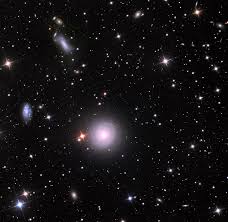
NGC 6340
NGC 6340 is a spiral galaxy with a visual magnitude of 11.9. It is located roughly 52 million light years away.
NGC 5879
NGC 5879 is a spiral galaxy that is a member of the NGC 5866 group. It has a magnitude of 12.4 and was discovered by William Herschel in 1788.
NGC 4319 and Markarian 205
NGC 4319 is a barred spiral galaxy in Draco that is located 92 million light years away and has a visual magnitude of 12.8. Markarian 205 is a quasar that is thought to be located in the vicinity of the galaxy. It is believed to be much further away from Earth than NGC 4319, almost 1.2 billion light years away
In 1971, a five meter telescope discovered a luminous bridge between NGC 4319 and Markarian 205. However, NASA disputed the existence of the bridge in 2002 with a photo taken by the Hubble telescope. That being said, the existence of the bridge is still up for debate.
If the bridge does exist, then it means that the two objects are not as far from each other as originally thought.
NGC 4236
NGC 4236 is a barred spiral galaxy that belongs to the M81 Group. It has a visual magnitude of 10.5.
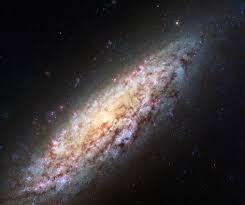
NGC 6503
NGC 6503 is a dwarf spiral galaxy in the Draco constellation that has an apparent magnitude of 10.2. It was discovered by the German astronomer Arthur Auwers in July 1854 and is around 17 million light years away from us.
It lies in the region of space known as the Local Void, which is a large, empty region of space next to the Local Group of galaxies. The NGC 6503 galaxy has a structure similar to that of the Milky Way, but it is only about a third of the size.
NGC 5949
NGC 5949 is a dwarf galaxy that was discovered by William Herschel on November 28, 1801. It is located 44 million light years from Earth and has an apparent magnitude of 12.70.
NGC 5949 contains only a relatively small number of stars and has a mass only about a hundredth that of the Milky Way, which is why it is classified as a dwarf.
PGC 39058
PGC 39058 is a dwarf galaxy found in Draco that is approximately 14 million light years away from us. It is difficult to observe because it is obscured by a bright star in front of it.
Extra Facts
- In mythology, Draco is sometimes represented as the Titan son of Gaia, Typhon.
- Traditional Arabic astronomy does not depict a dragon in modern-day Draco, which is called the Mother Camels. Instead, two hyenas, represented by Eta Draconis and Zeta Draconis are seen attacking a baby camel, which is protected by four female camels, represented by Beta Draconis, Gamma Draconis, Nu Draconis, and Xi Draconis.
- Draco Malfoy, from the Harry Potter series, is named after the Draco constellation.
- The main character in the 1996 film Dragonheart gets his name from the Draco constellation.
Images:
- Draco 1 – https://starregistration.net/constellations/draco-constellation.html
- Draco 2 – https://www.go-astronomy.com/constellations.php?Name=Draco
- Eltanin – https://www.star-facts.com/eltanin/
- Aldibain – http://www.astronomytrek.com/star-facts-aldebaran/
- Rastaban – https://theskylive.com/sky/stars/rastaban-beta-draconis-star
- Altais – https://theskylive.com/sky/stars/altais-delta-draconis-star
- Thuban – https://www.star-facts.com/thuban/
- Alsafi – https://theskylive.com/sky/stars/alsafi-sigma-draconis-star
- Kuma – https://en.wikipedia.org/wiki/Nu_Draconis
- Cats Eye Nebula – https://www.nasa.gov/multimedia/imagegallery/image_feature_211.html
- Spindle Galaxy – http://annesastronomynews.com/photo-gallery-ii/galaxies-clusters/the-spindle-galaxy-ngc-5866-m102/
- Tadpole Galaxy – https://apod.nasa.gov/apod/ap121108.html
- NGC 6503 – https://en.wikipedia.org/wiki/NGC_6503
- NGC 6340 – https://en.wikipedia.org/wiki/NGC_6340